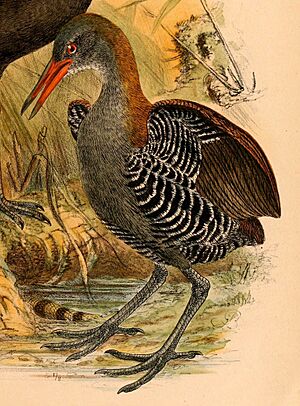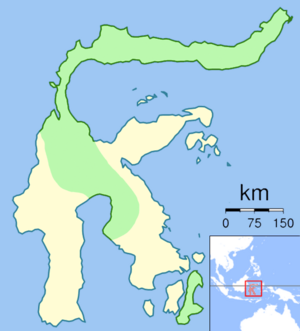Snoring rail facts for kids
Quick facts for kids Snoring rail |
|
|---|---|
 |
|
| From The Birds of Celebes and the neighbouring islands, 1898 | |
| Conservation status | |
| Scientific classification | |
| Genus: |
Aramidopsis
|
| Species: |
plateni
|
 |
|
|
Approximate resident range
Inset shows location of Sulawesi |
|
| Synonyms | |
|
Rallus plateni |
|
The snoring rail (Aramidopsis plateni) is a large bird that cannot fly. It is also known as the Celebes rail or Platen's rail. This bird is the only member of its group, called Aramidopsis.
You can only find the snoring rail in Indonesia, specifically on the island of Sulawesi and nearby Buton. It lives in thick plants in wet areas. This rail has grey feathers on its belly, a white chin, and brown wings. It also has a reddish-brown patch on the back of its neck.
Male and female snoring rails look similar. However, the female has a brighter neck patch. Her beak and eyes are also different colors. The bird gets its name from its special call, which sounds like a snore: ee-orrrr.
It is very hard to find the snoring rail because it lives in places that are difficult to reach. It also likes to stay hidden. Because of this, we do not know much about how it behaves. Scientists have only described what adult birds look like. We do not know how they raise their young.
The snoring rail eats small crabs and probably other tiny animals like lizards. This bird has been protected by Indonesian law since 1972. However, it is still in danger. Its home is being destroyed, and people sometimes hunt it for food. Other animals that are not native to the area also hunt it. Because of these threats, the snoring rail is listed as a vulnerable species. This means it is at risk of becoming extinct.
Contents
About the Snoring Rail's Name
The snoring rail belongs to a large bird family called rails. There are almost 150 different types of rails around the world. These birds are usually small to medium-sized. They live on land or in wet areas. Their bodies are often flat from side to side. This helps them move easily through thick plants. Many rail species that live on islands cannot fly. In fact, 32 out of 53 island rail species have lost the ability to fly.
A German bird expert named August Wilhelm Heinrich Blasius first described the snoring rail in 1886. He called it Rallus plateni. Later, in 1893, an English zoologist named Richard Bowdler Sharpe moved it to its own special group, Aramidopsis. This group has only one species, which is the snoring rail.
The name Aramidopsis comes from the name of another bird, the limpkin (Aramus). It also uses a Greek word part, opsis, which means "resembling." So, Aramidopsis means "resembling a limpkin." The species name plateni honors Carl Constantin Platen. He was a German doctor who collected birds and butterflies. He gave Blasius the first snoring rail specimen to study.
The common name "snoring rail" comes from the bird's unique call. A German insect expert, Gerd Heinrich, rediscovered the bird in 1932. He called it der Vogel Schnarch, which means "the snoring bird."
What Does the Snoring Rail Look Like?
The snoring rail is about 30 cm (12 in) long. It weighs between 143–160 g (5.0–5.6 oz). It cannot fly because it has short wings and a very short tail. It has strong legs and feet.
The bird's back and its front parts, from its head to its chest, are grey. It has a white chin. The sides and back of its neck are a bright orange-red color. Most of its upper body is brown. Its belly, sides, and the feathers under its tail have white stripes.
Male snoring rails have black legs, yellow eyes, and a brown and greenish beak that curves downwards. Female snoring rails are similar. However, their neck patch is brighter, and they have less white on their chin. Their eyes are red, and their beak is cream and reddish. Their legs are blue-grey.
We do not know what young or baby snoring rails look like. It is unlikely you would confuse the snoring rail with other rails in the area. The blue-faced rail is about the same size, but it is chestnut brown on top and black underneath. The buff-banded rail has very clear markings on its upper body, chest, and head. The slaty-breasted rail is smaller and has stripes on its upper body.
The snoring rail often makes a short wheez sound. This is followed by its special snoring sound, ee-orrrr. People have also heard it make a deep hmmmm sound.
Where Does the Snoring Rail Live?
This bird is rare and only lives in Indonesia. You can find it in the lowlands and hills of northern, north-central, and southeastern Sulawesi. Another group of these birds was found on Buton island in 1995.
The snoring rail prefers to live in thick plants in wet areas. This can include very dense bamboo and climbing plants in forests. It also lives in rattan plants in forests that have grown back. Sometimes, it lives in tall elephant grass and bushes on hillsides. Some people thought the bird lived in rice fields, but this was likely a mistake. They probably saw the buff-banded rail instead. The snoring rail can live from sea level up to 1,300 m (4,300 ft) high.
How Does the Snoring Rail Behave?
Because it lives in hard-to-reach places and is spread out, we do not know much about this bird. A few birds were collected by explorers in the late 1800s. After that, the rail was not seen for over 30 years. Then, Gerd Heinrich found it in 1932. He said it was "the most priceless catch that I have ever hunted or will hunt." Even a Dutch bird expert, Louis Coomans de Ruiter, spent a year trying to find the rail. He focused on places where it was known to live, but it was still very hard to spot.
After that, there were no recorded sightings until 1983 and 1989. It is still rare to see them. Only about ten dead birds have been studied by scientists.
The snoring rail catches crabs in mountain streams. Crabs might be a big part of its diet. It also looks for food in muddy areas. It has been seen eating lizards. We do not know anything about how it reproduces. There was one report of an adult bird feeding two chicks in August 1983. However, the original report did not give any details about this sighting.
Protecting the Snoring Rail
The snoring rail only lives on Sulawesi and Buton islands. Scientists believe there are between 3,500 and 15,000 of these birds left. Their numbers are thought to be going down. Because it lives in a small area and has a small population, the International Union for Conservation of Nature (IUCN) lists it as a Vulnerable species.
The snoring rail might always have been rare. However, many forests where it lives have been cut down. This means the bird is losing its home, and its habitat is being broken up. The rail has been protected by Indonesian law since 1972. Large national parks, like Lore Lindu National Park and Bogani Nani Wartabone National Park, are within its home range. But even in these protected areas, logging and rattan cutting still happen. People moving into these areas is also a problem at Lore Lindu.
In the past, people trapped the rail for food. Sometimes, dogs, cats, and other animals brought in by humans also kill them. A survey in 2007 looked for the rail in protected areas of Sulawesi. They did not find it. This suggests that the snoring rail is truly rare, even in places meant to protect it.


